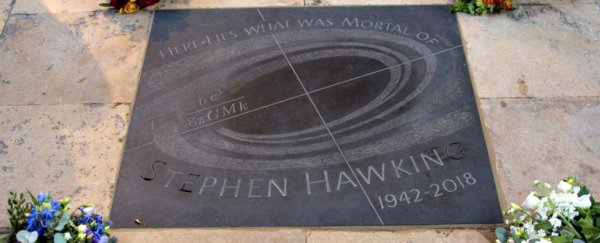The universe that Stephen Hawking spent a lifetime studying now knows his voice.
Following Hawking's death in March, the renowned British physicist, who had battled a debilitating degenerative motor neuron disease for decades, was remembered at a memorial service Friday at Westminster Abbey.
His ashes were buried between Charles Darwin and Isaac Newton and later covered with a gravestone — etched with an equation he used to teach the world about black holes.
But at the same time his ashes were lowered into the ground, his voice was beamed from Earth thousands of light-years away toward the nearest known black hole in the universe.
It was a "symbolic gesture," his loved ones said, that finally let him travel into space.
Family members, friends, fellow scientists and celebrities gathered Friday afternoon at Hawking's memorial service in London to celebrate his life and legacy.
"We come to celebrate the life and achievements of Stephen Hawking in this holy place where God has been worshiped for over a thousand years and where kings and queens and the great men and women of our national history and international influence are memorialized. We shall bury his mortal remains with those of his fellow scientists," the Rev. John Hall, dean of Westminster, said during the ceremony, according to Westminster.
"We shall give thanks for Stephen Hawking's remarkable gifts and for his life: for his years as Lucasian Professor of Mathematics at the University of Cambridge and for his international reach and influence as a scientist; for his personal courage, endurance, and perseverance living with motor neuron disease; and for his family and friends. We shall with love commend his immortal soul to almighty God."
Hawking's ashes were interred in the Scientists' Corner in Westminster Abbey and then fittingly covered with a gravestone etched with the equation he used to theorize that black holes are not completely black but faintly leak thermal radiation. That equation accompanied a depiction of a black hole along with the words, "Here lies what was mortal of Stephen Hawking, 1942-2018."
The memorial stone has now been placed on top of #StephenHawking's grave in Westminster Abbey. pic.twitter.com/bUTgm2UI7U
— Westminster Abbey (@wabbey) June 15, 2018
During the ceremony, Hawking's voice was also being beamed into the cosmos.
Greek composer Vangelis — most famous for his Academy Award-winning score to "Chariots of Fire" — set Hawking's voice to an original piece of music, which was sent into space through a massive antenna at European Space Agency's ground station in Spain.
"Around the time that our father was laid to rest, the Vangelis composition with our father's voice was broadcast into space," Hawking's daughter, Lucy Hawking, said in a statement, according to the European Space Agency. "This is a beautiful and symbolic gesture that creates a link between our father's presence on this planet, his wish to go into space, and his explorations of the universe in his mind."
During today's Service of Thanksgiving, the ashes of #StephenHawking were buried in Scientists' Corner. Professor Hawking's family placed flowers and a medal in the grave. pic.twitter.com/CgwoVYlDKU
— Westminster Abbey (@wabbey) June 15, 2018
Vangelis said in a statement posted on Hawking's website that he created the piece to "pay tribute and express my high esteem and respect to this extraordinary man." The composer added: "I imagine he will continue to travel with the same devotion, wherever he may be, in the known unknown. Farewell Professor Hawking."
It's unclear what Hawking said in the recording, but CDs were created for those who attended the memorial service Friday afternoon.
The European Space Agency said the ceremonial broadcast was beamed toward 1A 0620–00, a binary star system that includes a stellar-mass black hole — which is about 3,500 light-years from Earth.
"It is fascinating and at the same time moving to imagine that Stephen Hawking's voice together with the music by Vangelis will reach the black hole in about 3,500 years, where it will be frozen in by the event horizon," the agency's director of science, Günther Hasinger, said in the statement.
In March, Hawking, who was said to be perhaps the greatest scientist of his generation, died at 76 in his home in Cambridge, England.
As The Washington Post's Joel Achenbach reported, Hawking is most notably remembered for his theory that black holes "can emanate thermal radiation from subatomic processes at their boundary" — which is known as " Hawking radiation."
This revelation impressed other scientists with the way it took Einstein's general theory of relativity, which is essential for understanding the gravity of black holes, and connected it to newer theories of quantum mechanics, which cover subatomic processes.
Plus, he threw in a dash of old-fashioned thermodynamics — achieving a kind of physics trifecta.
"Black holes ain't as black as they are painted," Dr. Hawking once said in a lecture, characteristically describing complicated physics in ordinary language. "They are not the eternal prisons they were once thought. Things can get out of a black hole, both to the outside and, possibly, to another universe. So, if you feel you are in a black hole, don't give up. There's a way out."
He also hypothesized that miniature black holes, remnants of the big bang, may be strewn through space, though he noted that they haven't been discovered. "This is a pity, because if they had, I would have got a Nobel Prize," he joked.
2018 © The Washington Post
This article was originally published by The Washington Post.
